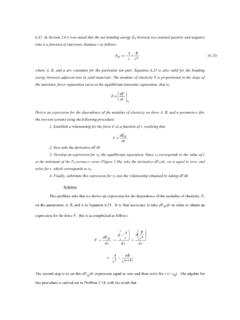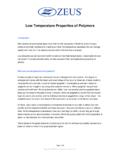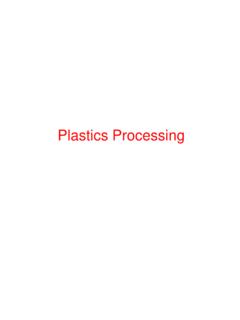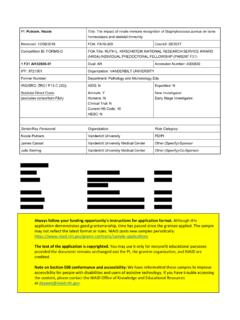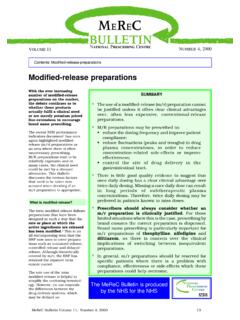Transcription of (a) Compute the repeat unit molecular weight of ...
1 (a) Compute the repeat unit molecular weight of polystyrene. (b) Compute the number-average molecular weight for a polystyrene for which the degree of polymerization is 25,000. Solution (a) The repeat unit molecular weight of polystyrene is called for in this portion of the problem. For polystyrene, from Table , each repeat unit has eight carbons and eight hydrogens. Thus, m = 8(AC) + 8(AH) = (8)( g/mol) + (8)( g/mol) = g/mol (b) We are now asked to Compute the number-average molecular weight .
2 Since the degree of polymerization is 25,000, using Equation M n= (DP)m=(25,000)( g/mol) = ! 106 g/mol Below, molecular weight data for a polypropylene material are tabulated. Compute (a) the number-average molecular weight , (b) the weight -average molecular weight , and (c) the degree of polymerization. molecular weight Range (g/mol) xi wi 8,000 16,000 16,000 24,000 24,000 32,000 32,000 40,000 40,000 48,000 48,000 56,000 Solution (a) From the tabulated data, we are asked to Compute M n, the number-average molecular weight .
3 This is carried out below. molecular wt Range Mean Mi xi xiMi 8,000-16,000 12,000 600 16,000-24,000 20,000 3200 24,000-32,000 28,000 6720 32,000-40,000 36,000 10,080 40,000-48,000 44,000 8800 48,000-56,000 52,000 3640 _____ M n =xiMi!=33,040 g/mol (b) From the tabulated data, we are asked to Compute M w, the weight -average molecular weight . molecular wt. Range Mean Mi wi wiMi 8,000-16,000 12,000 240 16,000-24,000 20,000 2000 24,000-32,000 28,000 5600 32,000-40,000 36,000 10,800 40,000-48,000 44,000 11,880 48,000-56,000 52,000 5720 _____ M w =wiMi!
4 =36,240 g/mol (c) Now we are asked to Compute the degree of polymerization, which is possible using Equation For polypropylene, the repeat unit molecular weight is just m = 3(AC) + 6(AH) = (3)( g/mol) + (6)( g/mol) = g/mol And DP=M nm=33,040 g/mol=785 High-density polyethylene may be chlorinated by inducing the random substitution of chlorine atoms for hydrogen. (a) Determine the concentration of Cl (in wt%) that must be added if this substitution occurs for 5% of all the original hydrogen atoms.
5 (b) In what ways does this chlorinated polyethylene differ from poly(vinyl chloride)? Solution (a) For chlorinated polyethylene, we are asked to determine the weight percent of chlorine added for 5% Cl substitution of all original hydrogen atoms. Consider 50 carbon atoms; there are 100 possible side-bonding sites. Ninety-five are occupied by hydrogen and five are occupied by Cl. Thus, the mass of these 50 carbon atoms, mC, is just mC = 50(AC) = (50)( g/mol) = g Likewise, for hydrogen and chlorine, mH = 95(AH) = (95)( g/mol) = g mCl = 5(ACl) = (5)( g/mol) = g Thus, the concentration of chlorine, CCl, is determined using a modified form of Equation as CCl = mClmC + mH + mCl x 100 = g + g + g !
6 100 = wt% (b) Chlorinated polyethylene differs from poly(vinyl chloride), in that, for PVC, (1) 25% of the side-bonding sites are substituted with Cl, and (2) the substitution is probably much less random. Make comparisons of thermoplastic and thermosetting polymers (a) on the basis of mechanical characteristics upon heating, and (b) according to possible molecular structures. Solution (a) Thermoplastic polymers soften when heated and harden when cooled, whereas thermosetting polymers, harden upon heating, while further heating will not lead to softening.
7 (b) Thermoplastic polymers have linear and branched structures, while for thermosetting polymers, the structures will normally be network or crosslinked. (a) Is it possible to grind up and reuse phenol-formaldehyde? Why or why not? (b) Is it possible to grind up and reuse polypropylene? Why or why not? Solution (a) It is not possible to grind up and reuse phenol-formaldehyde because it is a network thermoset polymer and, therefore, is not amenable to remolding.
8 (b) Yes, it is possible to grind up and reuse polypropylene since it is a thermoplastic polymer , will soften when reheated, and, thus, may be remolded. Explain briefly why the tendency of a polymer to crystallize decreases with increasing molecular weight . Solution The tendency of a polymer to crystallize decreases with increasing molecular weight because as the chains become longer it is more difficult for all regions along adjacent chains to align so as to produce the ordered atomic array.
9 Compute the elastic moduli for the following polymers, whose stress-strain behaviors may be observed in the Tensile Tests module of Virtual Materials Science and Engineering (VMSE): (a) high-density polyethylene, (b) nylon, and (c) phenol-formaldehyde (bakelite). How do these values compare with those presented in Table for the same polymers? Solution The elastic modulus is the slope in the linear elastic region (Equation ) as E =!
10 "!#= "2 $ "1#2 $ #1 Since all the stress-strain curves pass through the origin, we make take 1 = 0 and 1 = 0. Determinations of 2 and 2 are possible by moving the cursor to some arbitrary point in the linear region of the curve and then reading corresponding values in the Stress and Strain windows that are located below the plot. (a) For high-density polyethylene, we selected 2 = MPa with its corresponding 2 = Therefore, E = !2 " !1#2 " #1 = MPa " 0 " 0 = 395 MPa = GPa The elastic modulus (average) for high-density polyethylene given in Table is GPa, which is significantly higher than this value.

